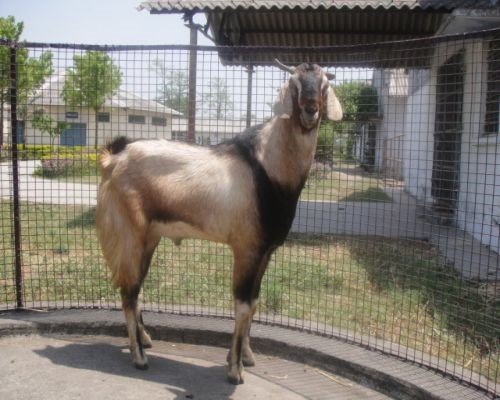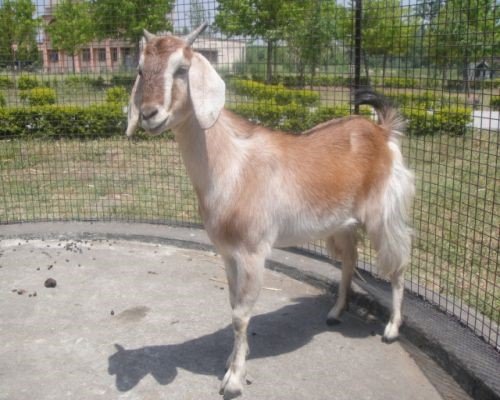BREEDS OF SHEEP AND GOAT
Sheep and Goat
INDIAN SHEEP BREEDS
Deccani
- Deccani breed is an admixture of the wooly types of Rajasthan and the hairy types of Andhra Pradesh and Tamil Nadu.
- It is found in Bombay-Deccan region and parts of Karnataka and Andhra Pradesh States.
- The sheep is small and hardy, and well adapted to poor pastoral conditions.
- It possesses a coloured fleece, black and gray colours being more dominant.
- The average annual yield of wool being 4.54 kg per sheep.
- The wool is of a low grade and is a mixture of hair and fine fibres, mostly consumed for the manufacture of rough blankets (Kambals).
- The flocks are maintained chiefly for mutton.

Macherla Sheep
- It is meat purpose breed, distributed in Guntur, Krishna and Prakasam district of Andhra Pradesh along with Padra and Amrabad mandals of Nagar Kurnool districts of Telangana.
- It is medium to large in size with coat color mainly white with large black or brown patches in the body, face and legs.
- Average adult body weight for male is 43 kg and for female is 35 kg.
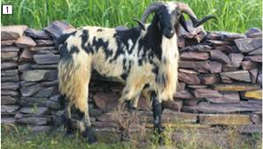
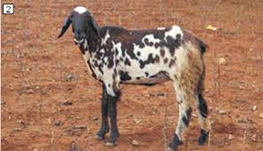
Nellore
- It is distributed in Nellore, Prakasam and Ongole districts of Andhra Pradesh.
- They are tall animals with little hair except at brisket, withers and breech.
- Rams are homed ewes are polled.
- Long and drooping ears;
- Majority of animals carry wattles.
- Males have average body weight of 36 kg and female have 28 kg.
- Nellore is the tallest breed of sheep in India, resembling goats in appearance.
- It has a long face and long ears with the body densely covered with short hair.
- The majority of the flocks are of fawn or deep red fawn colour.
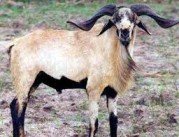
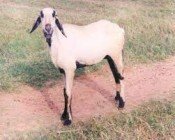
Bellari
- Native tract of distribution State District Karnataka Bellari and Davangere districts and adjoining areas of Haveri and Chitradurga
- The coat colour comprises various combinations of black and white to complete black. Most of the animals are black with patches of white all over the body including head, thorax, abdomen, belly and legs with coarse wool. The proportion of complete white animals is very low.
- Wattles present in about 80% of the animals
- Head profile is straight to slightly convex. Ears are tubular and medium in size. Ear length: Rams – 13.3±0.29 cm Ewes – 13.2±0.17 cm.
- About 89% of rams are horned, Only ~ 9.5% ewes horned, remaining polled. Thick at the base, corrugated & curved in rams with pointed tips with Backward, outward and downward orientation.
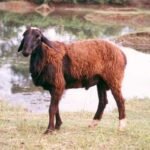
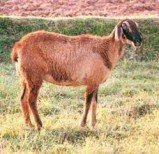
Hassan
- The Hassan breed of sheep as the name suggests is traditional to the Hassan district of Karnataka.
- They are small to medium animals and have a white body with light brown or black spots.
- The ears are medium-long and drooping, 39% of the males are horned; females are usually polled.
- The fleece is white, extremely coarse and open, and the legs and belly are generally devoid of wool.
- The face is usually black with the colour extending up to the neck. In some animals the legs are also black.
- Lambing rate is about 64% and the litter size is mainly single.
- The sheep are generally shorn twice a year. The average annual fleece weight is 300 to 400 gm.
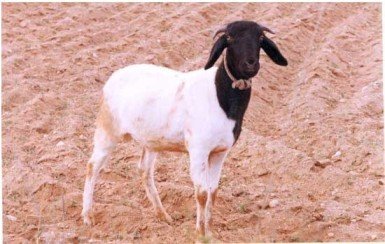
Kenguri
- The Kenguri breed, also known as Tenguri is native to the hilly tracts of the Koppal and Raichurs district in Karnataka.
- The sheep are large in size and have a body coat which is dark brown or coconut coloured.
- In most cases there is a white spot on the forehead and sometimes on the legs or other body parts. Males are horned while the females are generally polled. Most of the flocks are purebred.
- September to November is the main lambing season. The lambing rate is about 82% with an average lambing interval of 14 months.
- Litter size is single with rare cases of twinning. Kenguri sheep are primarily reared for meat.

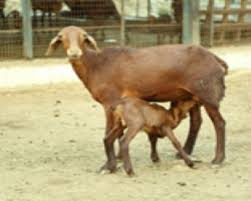
Mandya
- It is distributed in Mandya district of Karnataka.
- Relatively small animals colour white – sometimes face is light brown which may extend up to neck.
- Compact body with typical reversed “U” shaped conformation from the rear.
- Ears long, leafy and drooping.
- Both sexes polled.
- Coat extremely coarse and hairy adult male weighs 35 kg and female weighs 23 kg.
- Best mutton type conformation among the Indian breeds

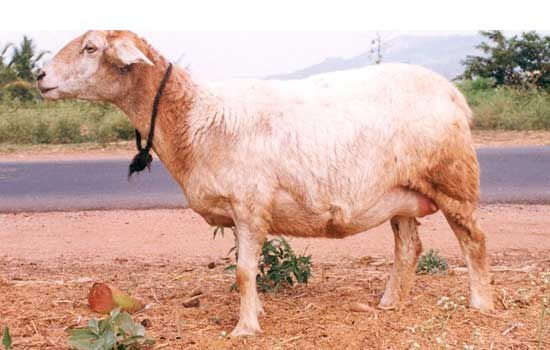
Katchaikatty
- Katchaikatty Black sheep are maintained in small flocks in Vedipatti taluka of Madurai district of Tamil Nadu.
- Animals are medium in size with compact body and are black in colour. Coat type is hairy. The breed is reared for meat and manure. Rams are well known for fighting.
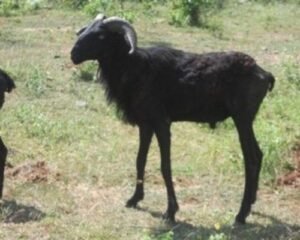
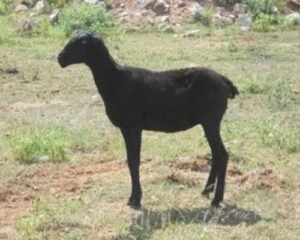
Chevaadu
- Also called as Arichevaadu. Breeding tract is Tirunelveli (tamilnadu)
- The attractive brown coat colour gives a better value to the chevaadu which is preferred by the hindus for their religious purpose.
- This fetches more price and profit to the flock owners. Males are specially utilized to serve the cultural purposes of the local inhabitants.
- The name arichevaadu stands for light brown coloured body coat.
- Chevaadu is considered as unique economically important breed as it survives on dry land as well as near coastal area ecosystem.
- Colour is light brown. Some are dark brown and few tan with hairy coat.
- Highly corrugated, curved horizontally outward, backward with blunt conical apex having few thick ridges. Size 10 – 42 cm.
- Dorsal part of the body is light brown in colour and the ventral part, from the jaw to inguinal region, is lighter than the dorsal part of the body, head is erected and high in disposition
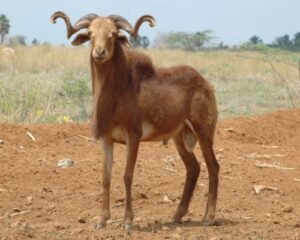
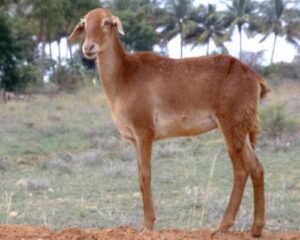
Mecheri
- It is distributed in Salem, Erode, Karur, Namakkal, and fewer parts of Dharmapuri districts of Tamilnadu.
- It is a meat purpose breed.
- It has medium sized body with pale purplish skin color.
- There are no horns for both the sexes.
- Tail is smaller and slender.
- Adult male average body weight 36kg.
- Adult female average body weight 22kg.
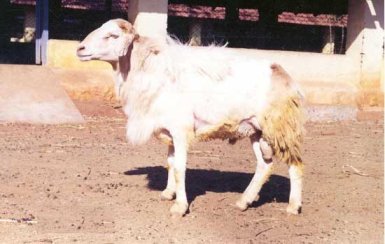
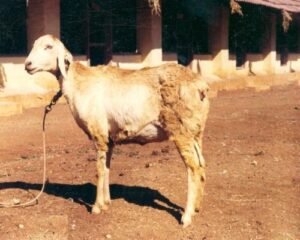
Chennai red
- This is distributed in Chennai, Kancheepuram, Villupuram, Thiruvannamalai districts of Tamilnadu.
- It is meat purpose breed.
- Majority are purple in color.
- Certain animals have colored stripes on their forehead.
- Adult male average body weight 36kg.
- Adult females average body weight 24 kg.
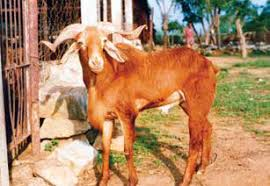

Ramanadhapuram white
- This is distributed in Ramanadhapuram, Sivagangai, and Virudhunagar districts of Tamilnadu.
- It is meat purpose breed.
- It has medium sized body.
- Majority of them are white in color.
- Certain goats hold black colored stripes all over their body.
- Adult males have their bent horns, whereas females with absence of horns.
- Legs are smaller and slender.
- Adult male average body weight 31kg.
- Adult female average body weight 23kg.
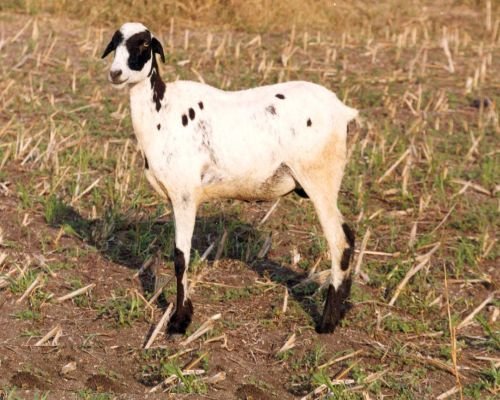
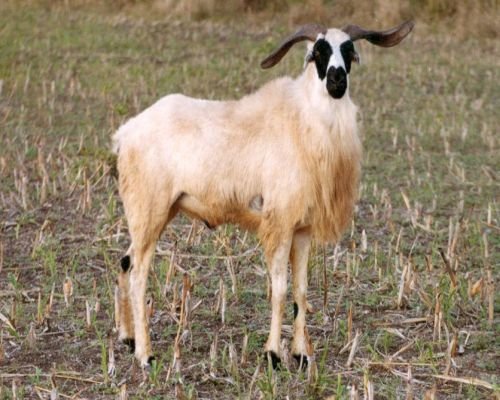
Keezhakaraisal
- This is distributed in Ramanadhapuram, Sivagangai and Thirunelveli districts of Tamilnadu.
- It is meat purpose breed.
- It has medium sized body.
- It is found in black red skin color.
- Black colored bands are found on the skin in the regions of head, stomach and legs.
- Tail is smaller and slender.
- Adult male goats are found with stronger coiled horns.
- Majority of the goats are found with wattle, under the jaw/throat.
- Adult male average body weight 29kg.
- Adult female average body weight 22kg.
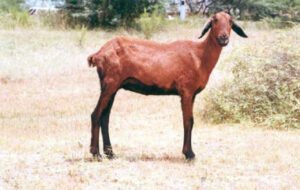
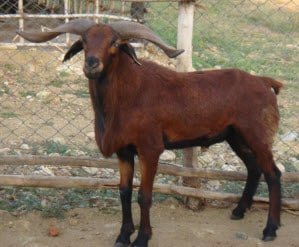
Vembur
- It is distributed in Vembur, melakarandhai, keezha karandhai, nagalapuram regions, Tuticorin and Virudhunagar districts of Tamilnadu.
- It is meat purpose breed.
- These are taller breeds.
- They have white color skin with red color spots over their body.
- Ears are drooped out.
- Tail is smaller and slender.
- Adult males are found with horns and absence of horns in case of females.
- Adult males average body weight 35kgs.
- Adult females average body weight 28kgs.
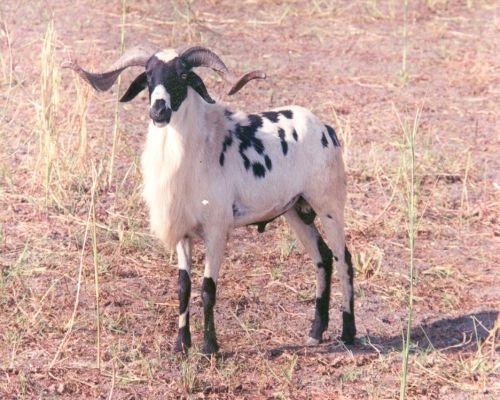
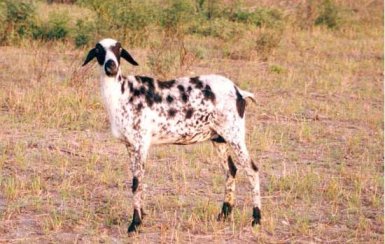
Neelagiri
- These are distributed in Neelagiri district of Tamilnadu.
- It is wool purpose breed.
- They are medium weighed animal.
- Majority are found in white colors.
- Certain goats are found with purple spots on their body and face.
- Ears are broad and drooped out.
- Females are without horns.
- Adult male average body weight 31kg.
- Adult female average body weight 31kg.
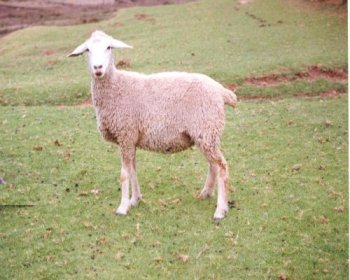
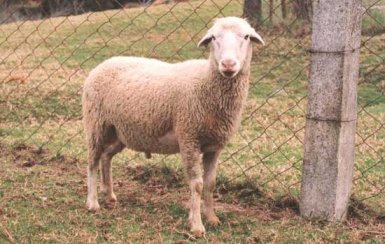
Trichy black
- These are distributed in Trichy, Perambalur, Dharmapuri and Salem districts of Tamilnadu.
- It is wool purpose breed.
- These are smaller breeds.
- Black coloured all over the body.
- Adult males are found with horns and females without horns.
- Ears are smaller, facing forward and downwards.
- Adult male average body weight 26kg.
- Adult female average body weight 19kg.
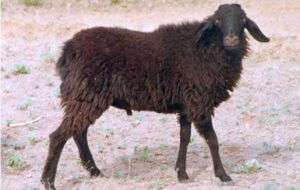
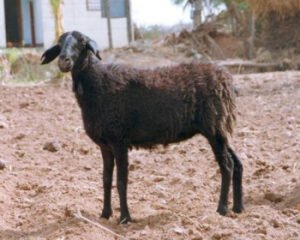
Coimbatore
- It is distributed in Coimbatore district of Tamilnadu.
- It is wool purpose breed.
- Medium weighed animal.
- Found in white colors, with black or purple colored bands, seen over the regions of head and neck.
- 30% of adult females are free of horns.
- Adult male average body weight 25kg.
- Adult female average body weight 20kg.
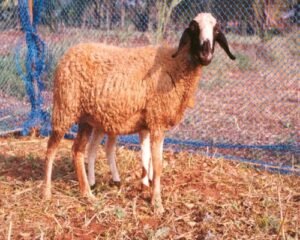
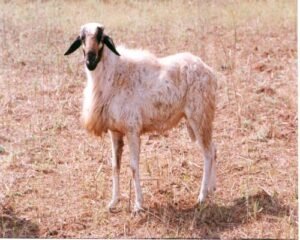
Chokla
- Chokla also known as Chhappar and Shekhawati is native to the districts of Churu, Nagaur and Sikar in Rajasthan.
- Chokla is perhaps the finest carpet-wool breed, although most Chokla wool is now being diverted to the worsted sector because of a dearth of fine apparel-wool in the country.
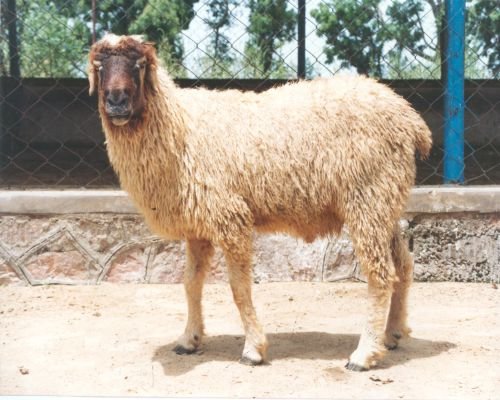
- They are light to medium-sized animals. The face, generally devoid of wool, is reddish brown or dark brown, and the colour may extend up to the middle of the neck; the skin is pink.
- The ears are small to medium in length and tubular. Both sexes are polled. The tail is thin and of medium length.
- The coat is dense and relatively fine, covering the entire body including the belly and the greater part of the legs.
- Age at first breeding for males is 15 months and for females is 24 months. Lambing percentage is about 75 and the litter size is single with rare cases of twinning.
- Male lambs are sold for slaughter between the ages of 5 to 7 months.
Jaisalmeri
- The name of the Jaisalmeri breed is derived from its home tract, Jaisalmer. They are distributed across the Jaisalmer, Barmer and Jodhpur districts of Rajasthan.
- In terms of body size, this is the largest breed among the eight breeds of Rajasthan, and produces good quality carpet-wool.
- They are tall, well-built animals, with black or dark brown faces, with the colour extending up to the neck.
- Other characteristics include a typical Roman nose and long drooping ears, generally with a cartilaginous appendage. Both sexes are polled.
- The tail is medium to long and the fleece colour is white.
- Age at first breeding is 15-18 months for rams and 12-15 months for ewes. Lambing percentage is about 55 to 60. Litter size is usually single.
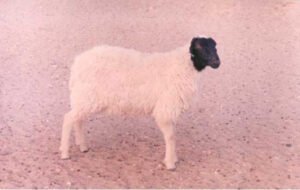
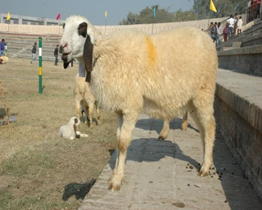
Magra
- The Magra breed (formerly known as Bikaneri; and also known as Bikaneri Chokhla and Chakri) is distributed in the Bikaner, Nagaur, Jaisalmer and Churu districts of Rajasthan.
- This is the only lustrous carpet-wool producing breed in the state. The most important strain of Magra has flocks with extremely white and lustrous fleece, found only in a few villages around Bikaner.
- They are medium to large animals, with a white face with light brown patches around the eyes, which is a characteristic feature of this breed. The skin colour is pink; ears are small to medium and tubular. Both sexes are polled. Tail is medium in length and thin.
- Age at first breeding is 18 months for ewes and 20 months for rams. Lambing percentage is about 45 and the litter size is mostly single.
- Magra ewes are not milked. Most flocks produce their own rams, and some exchange rams with other owners. Traditionally, the shearing of wool is done thrice a year, and the wool produced is locally known by the season/ month of its production.
- The three varieties of wool include Siyadu (winter wool), Ashadhu (monsoon wool) and Chaitu (summer wool). The first two types have a yellowish/ saffron tinge, and are therefore also called the Chandaniya variety (from chandan, meaning sandalwood).
- Chaitu is the most preferred of the three wool types because of its white colour and lesser presence of external organic/ inorganic matter.
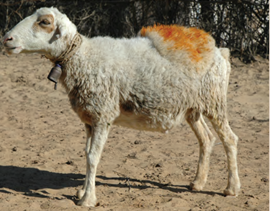
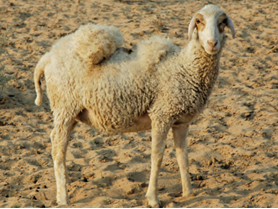
Malpura
- The Malpura breed is native to the Tonk, Sawai Madhopur, Jaipur and Dausa districts and adjacent areas of Ajmer, Bhilwara, Chitaurgarh, Kota and Bundi districts in Rajasthan. They derive their name from the Malpura Taluk in Tonk district in Rajasthan.

- The Malpura are very similar to the Sonadi breed but with improved wool production and quality and are larger in body size. The face is light brown and ears are short and tubular, with a small cartilaginous appendage on the upper side. Both sexes are polled. The tail is medium to long and thin and the fleece is white, extremely coarse and hairy. The belly and legs are devoid of wool. Age at first breeding in farmers’ flocks is 10 months for males and 12 months for females. The litter size is single.
- Malpura ewes yield good quantity of milk and farmers milk them when the lambs are weaned. They produce an average milk yield of 300-500 gm per day. Under farmers’ flock conditions, males for slaughter are sold at ages ranging from 6 to 9 months. The average annual fleece weight is 1.08 kg
Nali
- The Nali breed is well adapted to the arid and semi-arid regions of Rajasthan and Haryana. It is also found in large numbers in Uttar Pradesh.
- It derives its name from the route of the river Ghaggar flowing through Ganganagar and Hanumangarh district of Rajasthan. Nali sheep are maintained primarily on grazing and on the leaves of fodder trees like Khejri and Babool.
- They are medium-sized animals. The face colour is light brown, and the skin colour is pink.
- Both sexes are polled, their ears are medium and tubular, tail is short to medium and thin, fleece is white, coarse, dense and long-stapled.
- The forehead, belly and legs are covered with wool.
- The age at first breeding for ewes is 18 months and for rams it is 12 months; the lambing percentage is 67 and the litter size is mainly single.
- These animals are not milked. Males not retained for breeding are usually sold between the ages of 6 to 9 months.
- The annual average fleece weight ranges from 1.5 to 3 kg
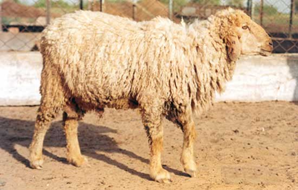
Pugal
- The name of the Pugal breed originates from the Pugal tehsil of Bikaner district, which is the home tract of this breed.
- They are fairly well-built animals with a distinct black face with small light brown stripes on either side above the eyes; the lower jaw is typically light brown.
- The black colour may extend to the neck. Ears are short and tubular.
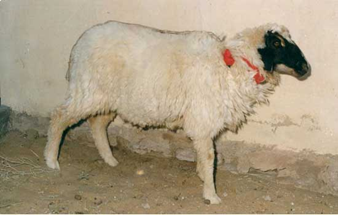
- Both sexes are polled. The tail is short to medium and thin and the fleece is white, of medium carpet quality, not very dense.
- Age at first breeding for ewes is 15 months and for rams it is 18 months. The litter size is generally single. Rams are selected for breeding on the basis of fleece production, and are generally produced within the flock.
- The average annual fleece weight is 1.60 kg
Sonadi
- The Sonadi breed is found in the Mewar region of Rajasthan comprising Udaipur, Dungarpur, Chittaurgarh and Banswara districts. They are also locally known as Laapdi (long flat drooping ears) and Bhagli (of good fortune).
- The Sonadi is an important sheep breed of Rajasthan and is said to have evolved over many generations as the sheep migrated to neighbouring Madhya Pradesh and crossed with local herds there.
- Shepherds have bred these animals for their characteristics and adaptation to the physical environment. The breed is known for its milk and meat production.
- They are well-built, somewhat smaller than the Malpura, with long legs. They have a light brown face with the colour extending to the middle of the neck. Ears are large, flat and drooping and generally have a cartilaginous appendage. The tail is long and thin.
- Both sexes are polled. The udder is fairly well developed. The fleece is white, extremely coarse and hairy. The belly and legs are devoid of wool.
- Age at first breeding in farmers’ flocks is 10 months for males and 12 months for females.
- The litter size is generally single.
- The lactation period is 105 days and the yield is about 24 kg. The average annual fleece weight is 900 gms

Marwari
- Sheep are hardy, yielding coarser carpet variety white wool of a mixed hairy composition.
- This sheep is characterized by long legs, black face and a prominent nose.
- Fleshy appendages under throat, known as wattles, are often present.
- Tail is short and pointed.
- The sheep are found all over Jodhpur and parts of Jaipur districts.
- Flocks are raised in Pali and Barmer districts.
- The animals migrate to distant places in Uttar Pradesh, remote districts of Madhya Pradesh and sometimes to the northern parts of Maharashtra.
- They possess high resistance to disease and worms.
- The yield of wool per year is 0.90-1.81 kg per animal.


Gaddi
- Sheep are small in size, and are found in Kishtwar and Bhadarwah tehsils of Jammu.
- A large number inhabit the Kulu valleys in HP winter, and in summer they graze the highest elevations of them Pir Panjal Mountains, mostly in the Paddar range.
- Rams are horned, ewes hornless; fleece is generally white with brown coloured hair on the face.
- Wool is fine and lustrous; average annual yield is 1.13 kg per sheep, clipped thrice a year.
- A part of this clip is sent to Dhariwal mills and Amritsar markets.
- Undercoat is used for the manufacture of high quality Kulu shawls and blankets.
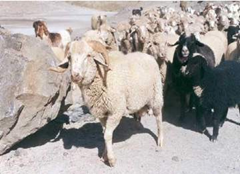
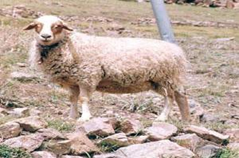
Jalauni
- The Jalauni breed is distributed across the Jalaun, Jhansi and Lalitpur districts of Uttar Pradesh.
- The Jalauni are medium-sized animals, with a straight nose line. The colour of the body is white with a light brown or black head.
- Both sexes are polled. Ears are large, flat and drooping and the tail is thin and medium in length. The fleece is coarse, short-stapled and open, generally white. The belly and legs are devoid of wool.
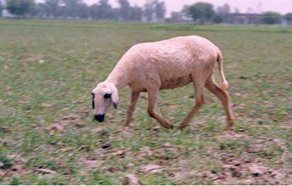
- Usually one breeding ram is maintained per flock. The litter size is primarily single. Jalauni sheep are maintained for meat and wool.
- The wool quality is coarse and shearing is done three times a year, with an average wool production of about 150-200 gm per clip.
Muzzafarnagari
- The Muzaffarnagri, also known as Bulandshahri is native to the Muzaffarnagar, Bulandshaher, Saharanpur, Meerut and the Bijnor districts of Western Uttar Pradesh.
- The breed is primarily maintained for meat, however, it also produces fleece of coarse carpet quality.
- The breed is one of the heaviest and largest of India’s sheep breeds and well adapted to irrigated areas.
- They are medium to large animals with a face line that is slightly convex. The face and body are white with occasional patches of brown or black. The ears and face are occasionally black.
- Both sexes are polled. Males sometimes show rudimentary horns. The ears are long and drooping. The tail is extremely long and reaches the fetlock. The fleece is white, coarse and open. The belly and legs are devoid of wool.
- Age at first lambing is between 16 to 18 months; lambing percentage ranges from 60 to 95%. The litter size is mostly single.
- Males are bred from within the flock and selected mainly on the basis of body size.
- Daily milk yield ranges from 300 to 500 ml with a lactation period of 120 to 180 days.
- The average annual greasy fleece weight is about 600 gm to 1 kg.
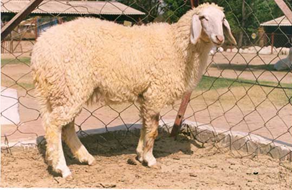
Kendrapada
- Synonyms are Deshi, kuzi
- Breeding tract is Cuttack, puri, jagatsinghpur, jajpur, bhadrak, kendrapara (odisha)
- These sheep are popular for good quality skin, manure and low fat mutton. Some uncastrated males or rams are used for religious purpose.
- Colour brown, Horns absent, Button type horns are present only in few males
- Visible characteristics include head, face, belly and legs are bare. Rest of the body is covered with non-lustrous hair. Animals have horizontal ears; short, straight and drooping tail.
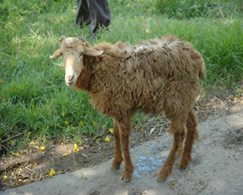
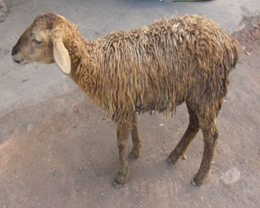
Balangir
- The Balangir breed of sheep is native to the north western districts of Balangir, Sambalpur, and Sundargarh in Odisha.
- They are medium-sized animals, white or light brown or of mixed colours. A few animals are also black.
- The ears are small and stumpy. While the males are horned, ewes are polled. The tail is medium long and thin. The fleece is extremely coarse, hairy and open, and the legs and belly are devoid of wool.
- Lambing percentage is about 84.3% and the litter size is single.
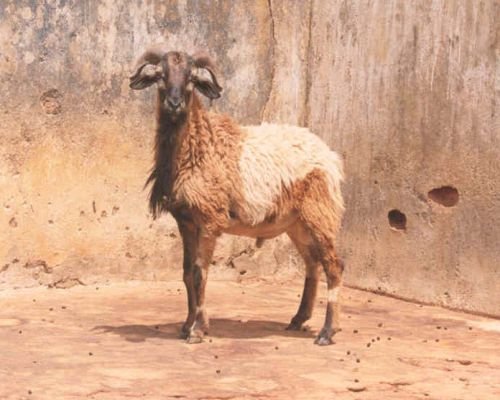
Ganjam
- The Ganjam breed of sheep is native to the Ganjam, Koraput, Phulbani and parts of the Puri districts of Odisha.
- These are medium-sized, slender and leggy animals with the coat colour ranging from brown to dark tan; some have white spots on the face and body.
- The ears are medium-sized and drooping, and the tail is medium long and thin. The males are horned, while the ewes are polled.
- The fleece is hairy and short, and is not sheared. Rams, however, have long hair below the neck and hindquarters.
- Ganjam sheep are primarily maintained for meat. Lambing percentage varies from 60-90% and the litter size is mainly single.
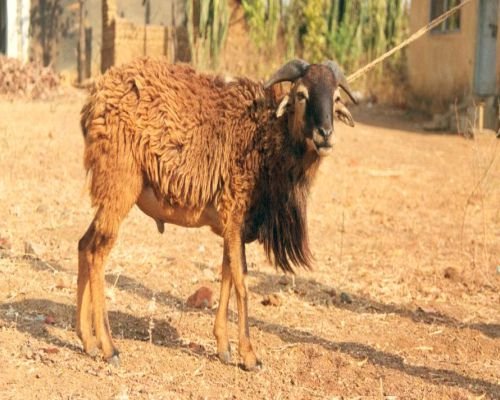
Kajali
- Large sized animals with well-built body distributed in Sangrur, Barnala, Ludhiana, Moga and adjoining districts in Punjab.
- Kajali sheep has two types /colour variants: Black (Kali) and White (Chitti) Kajali. Black Kajali have complete black or black-brown or brown body.
- White Kajali have complete white coat with black or dark brown circle/patch around the eyes, and in face and ears.
- These sheep have roman nose, long and pendulous ears, and long tail touching the ground (about 55cm). Primarily reared for mutton production.
- Average adult weight is about 57 kg in males and 43 kg in females. It produces white or black/brown coloured coarse wool (0.8 – 1kg).
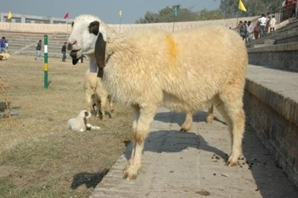
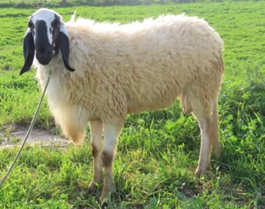
Garole
- The Garole breed is native to the hot, humid and swampy Ganges delta of West Bengal. It is a small-sized animal, reared for meat.
- It has a compact and square body with a small head, medium ears and a short thin tail. Grey and white are the predominant colours.
- Males are usually horned and females are polled. The fleece is open and very coarse and, though not dense, covers almost the whole body and a major part of the legs.

- The animals are usually not shorn, though some farmers shear the animal and use the wool for bedding material.
- Garole ewes breed around the year with two lambing peaks between December to February and August to September. Multiple births are common.
Bonpala
- The Bonpala breed is native to southern Sikkim.
- The animals are tall, leggy and well-built. The fleece colour ranges from completely white to completely black with a number of intermediary shades, and the quality is coarse, hairy and open.
- The ears are small and tubular and both sexes are horned. The tail is thin and short and the belly and legs are devoid of wool.
- Shearing is generally undertaken twice annually producing about 400-500 grams of wool per year.

Shahbadi
- The Shahabadi, is native to the erstwhile Shahabad (subsequently bifurcated into the Bhojpur, Rohtas and Buxar districts), Patna and Gaya districts of Bihar
- They are medium sized leggy animals. The fleece colour is mostly grey, sometimes with black spots.
- Ears are medium-sized and drooping, and the tail is extremely long and thin. Both sexes are polled.
- The fleece is extremely coarse, hairy and open, and the legs and belly are devoid of wool.
- Flocks generally comprise 5 to 6 rams and 70 to 80 adult ewes and their young. The average annual fleece weight is 240 gms

Chottnagpuri
- The Chhotanagpuri breed is mainly found in Jharkhand, with a few numbers in Bihar. They are small, light-weight animals, light grey and brown in colour.
- Ears are small and parallel to the head, the tail is thin and short and the fleece is coarse, hairy and open.
- The animals are shorn thrice a year in March-April, June-July and October-November, and produce a yearly average of 180 g of hairy wool,
- Both sexes are polled. They are considered a coarse carpet wool breed.
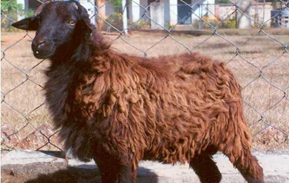
Patanwadi
- The Patanwadi (also called Desi, Kutchi, Kathiawari, Vadhiyari and Charotari) is found in the coastal plains of the Saurashtra and Kutch regions of Gujarat, and the sandy loamy areas of Patan, Panch Mahals and Mehsana districts of Gujarat.
- Three distinct strains are found –
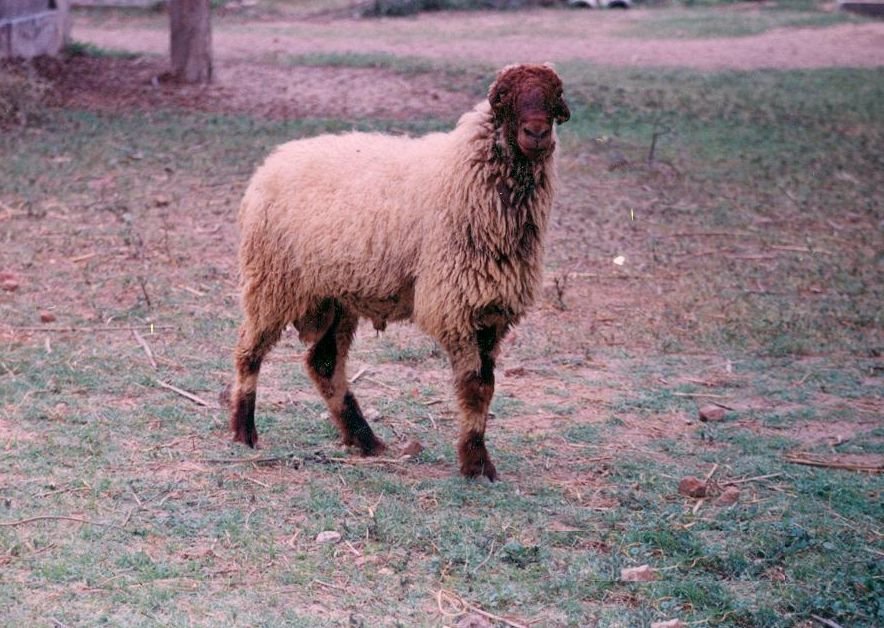
- non-migratory, red-faced animals with small bodies, yielding relatively finer fleece. These are typical Patanwadis and are found in north eastern Saurashtra;
- the migratory type, with a larger body and long legs, a typical Roman nose and long tubular ears. This variety, which has coarser fleece, is found in western and north eastern Gujarat;
- The meat type, with a big body, low stature and a coarse fleece, found in the south eastern part of the state around Palitana.
- Patanwadi is a superior carpet-wool breed and requires efforts for conservation. Both sexes are polled.
- Lambing percentage on the basis of ewes bred is 79 and the litter size is generally single.
- Ewes are milked for about 3 months. The average annual fleece weight is 1.17 kg for rams and 1.03 kg for ewes.
Panchali
- Panchali is a dual purpose sheep reared for milk & meat in Panchal area of Gujarat.
- Animals are large in size, and have long legs and excellent migration ability. Coat color is white.
- Head or facial parts are black, blackish brown, brown and light brown in color. Ears are long and pendulous. Tail is long.
- Udder is well-developed. Milk yield ranges from 0.4 to 1.2 litre/ day.
- Animals attain 18 to 20kg body weight at 3 to 4 months of age. Adult weight varies from 53 to 82kg in males and 32 to 73kg in females.
- Wool is coarse and annual production is nearly one kg.
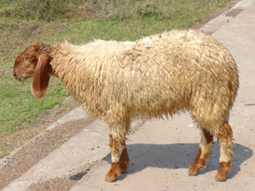
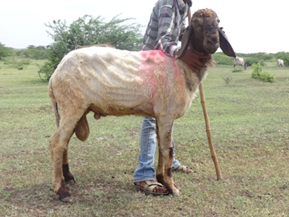
Gaddi
- They are one of eight different breeds of sheep found in the northern temperate area of India.
- The Gaddi is raised primarily for its wool.
- The ram is horned while the ewes are found horned only 10 – 15% of the time.
- The tail is small and thin. The breed is considered medium-sized.
- The ewe averages 56 cm at the withers and weighs on average 26.5 kg.
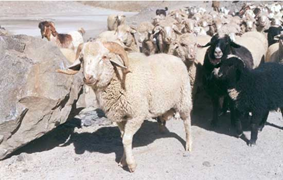
- Lambs at birth weigh 2.5 kg and there is no difference in average birth weight between rams or ewes. This breed is small in size.
- It is strong and a good climber. Ears are also short. Fleece is fine and can grow up to 5m length.
- Fleece is clipped three times a year (Feb, June and October). Fleece yield is 1–1.5kg/year. Wool is used for making shawls and blankets.
- Generally, the breed is uncolored and white. Occasionally, found mixed tan, brown and black.
Rampur Bushair
- The Rampur Bushair breed is fairly widespread in Himachal Pradesh and a few numbers are found in the Uttarkashi, Almora and Udham Singh Nagar districts of Uttarakhand.
- They are medium-sized animals. The fleece colour is predominantly white, with brown, black and tan also seen in varying proportions.
- The ears are long and drooping. The face line is convex, giving a typical Roman nose. The males are horned; most females are polled.
- The fleece is of medium quality and dense. The legs, belly and face are devoid of wool.
- Under farm conditions lambing percentage varies from 52.9 to 88.3%.


Bhakarwal
- The name of the Bakharwal breed is derived from the nomadic tribe which rears these sheep. The breed has no distinct home tract, and the sheep are entirely migratory.
- Bakharwal sheep flocks, winter in the Pir Panjal ranges of the Jammu division, and in the summer migrate to the Kashmir Valley, crossing the high mountain passes.
- They are medium-sized animals, with a typical Roman nose.
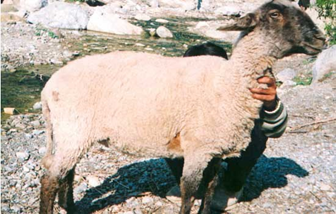
- All animals are spotted fawn or grey. The rams are horned and the ewes are polled. The ears are long and drooping, and the tail is small and thin.
- The fleece which is coarse and open is generally white, although coloured fleeces are occasionally observed. They are a coarse carpet wool breed of sheep.
- Adult ewes weigh between 29 and 36 kg; rams can weigh as much as 55 kg.
- The sheep are shorn three times a year. The total annual wool produced per animal ranges from 1 to 1.5 kg.
Changthangi
- The Changthangi or Changpa is a breed of cashmere goat native to the high plateaus of Ladakh in northern India.
- It may also be known as the Ladakh Pashmina or Kashmiri.
- These goats provide the wool for Kashmir’s famous pashmina shawls. Shawls made from Pashmina wool are considered very fine, and are exported worldwide.
- The Changthangi goats have revitalised the poor economy of Changthang, Ladakh where the wool production generates more than $8 million a year.
- They are also used as pack animals and for meat
- Skin colour: white or light brown
- Wool colour: usually white, also black, brown or grey
- Horned in both sexes.
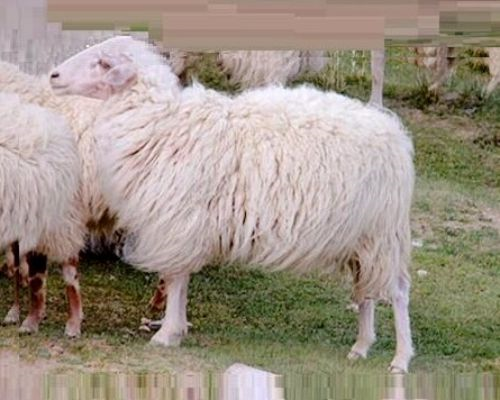
Gurez
- The Gurej breed is found in the Gurez block of Bandipore district in North Kashmir. They are the largest of the sheep breeds in the state.
- The Gurej is generally white in colour, although some animals are brown or black or have brown or black spots.
- A small proportion of the animals have small, pointed horns. Some animals have multiple horns up to 4 to 6 in number. The tail is thin and short.
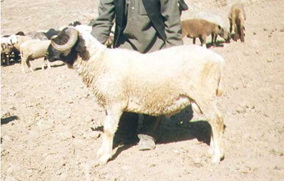
- The fleece is generally coarse and hairy. Ears are long, thin and pointed.
- Gurej is one of the finest carpet wool sheep breeds of the state. There is considerable cross-breeding with the Merino for improving apparel-wool production and quality.
- The annual greasy-fleece weight varies from 0.8 to 1 kg per animal. Breeding takes place mainly in August-September and to a limited extent in February-March.
- Around 45% of the sheep are shorn three times a year and the remaining twice.
Karnah
- One of the notable breed in Kashmir is the Karnah Sheep. These sheep are valued for their superior meat and high-quality wool.
- These sheep have adapted to harsh climates and rugged terrains.
- Body colour is white with a few animals having black or brown spots on face.
- Horns present. 94% rams have large curved horns. All females are polled. Horns take a backward turn and then forward and upward with pointed tips
- Animals are large with a deep body. Ears are pendulous and medium sized. Prominent nose line.

Poonchi
- The Poonchi breed, as its name suggests, is native to the Poonch and Rajouri districts of the Jammu region of Jammu and Kashmir.
- The weight of an adult ram ranges from 35 to 40 kg, and that that of a ewe from 25 to 30 kg.
- The Poonchi breed is similar in appearance to the Gaddi, but lighter in colour. Animals are predominantly white, including the face, but spotted sheep are also seen, varying from brown to light black.
- The ears are medium long. The tail is short and thin. The legs are also short, giving a low-set conformation.
- The wool is of medium to fine quality, mostly white in colour. Sheep are shorn three times a year and produce between 0.9 to 1.3 kg of greasy wool each per year.
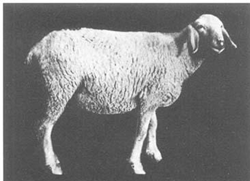
EXOTIC SHEEP BREEDS
Dorset
- This is native of U.K and are polled and horned.
- Face, ears and legs white in colour and free from wool.
- Wool yields 2.75 to 3.25 kg produce mutton of superior quality.
- Rams weight 80-110 kg and ewes weigh – 50 to 80 kg.
- It is a hardy breed and capable of performing well under most conditions.
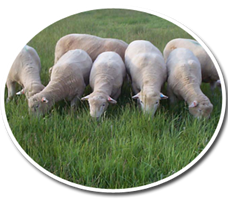
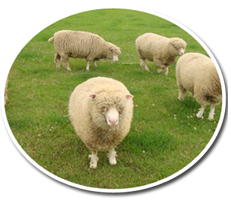
Suffolk
- It is native of U.K. and is large animals with black face, ears and legs.
- Head and ears entirely free from wool.
- Both rams and ewes are polled though rams sometimes have scurs.
- Its average wool yield 2-3 kg.
- Mature Rams weigh 100-135 kg and ewes from 70-100 kg.
- Ewes are very prolific and excellent milkers.
- Suffolks imported to India have performed poorly than Dorsets.
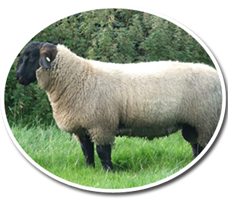
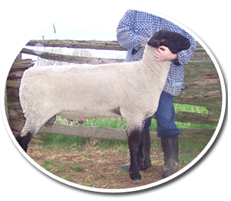
Merino
- The most popular fine wool breed of the world, originated in Spain.
- It is a white faced sheep with white feet.
- Rams have horns whereas the ewes are hornless.
- Most of the head and legs are covered by wool.
- The animal is extremely hardy being able to survive under adverse weather and poor grazing conditions.
- The ewes live and yield longer than any other breed.

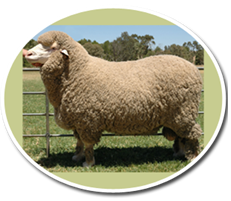
Rambouillet
- It was developed in France.
- This breed has a large head with white hair around the nose and ears.
- Rams have horns and ewes are hornless.
- Rams weigh as much as 125 kg and ewes up to a maximum of 90 kg.
- It produces an excellent fine-wool fleece.
- The fleece is heavy, close, compact, covering most of the body including face and legs
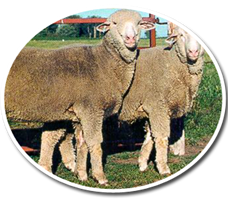
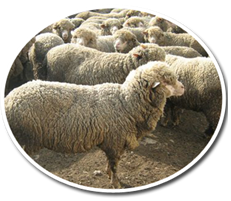
Cheviot
- Is a medium wool breed, primarily developed in Scotland.
- The breed is small with erect ears, a clean white face and white legs, covered with short white hair.
- The nose, lips and feet are black.
- Rams weigh on an average upto 80 kg and ewes up to 55kg.
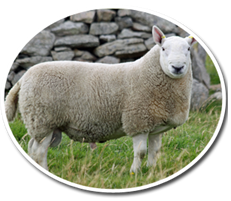

Southdown
- This breed is one of the oldest English breeds and has greatly contributed to the development of many other breeds of sheep.
- It is a small sheep excellent for mutton production.
- Body is low-set, compact, wide and deep with legs wide apart. Head is broad; face is light brown coloured.
- Rams weigh about 80 kg and ewes 55kg at maturity.


GOAT BREEDS
INDIAN GOAT BREEDS
Jamunapari
- Jamunapari breeds are found mainly in the state of Uttar Pradesh.
- Its coat colour is white with tan or black markings at neck and ears
- They are beard in both sexes; havetuft of long hairs in the buttocks.
- It is largest and most elegant of the long-legged goats of India.
- It has pronounced Roman nose having a tuft of hair which results in parrot mouth appearance.
- Their horns are short and flat and horizontally twisting backward.
- An adult male ranges from 90 to 100 cms in height, whereas a female goat ranges from 70 to 80 cms in height.
- It is, tall and leggy with convex face line and large folded pendulous ears.
- Generally found in white colors.
- Their ears are large and drooped downwards.
- An adult female weighs between 45kgs to 60kgs, whereas an adult male ranges between 65kgs to 80kgs.
- Average birth weight is up to 4 kg.
- Average age at first kiddingis 20-25 months.
- They have large udder and big teats and average yield is 280 kg / 274 days.
- Have the ability to yield 2 to 2.5kgs of milk per day.
- The fat content of the milk ranges between 3 to 3.5%.
- They thrive best under range conditions with plenty of shrubs for browsing.
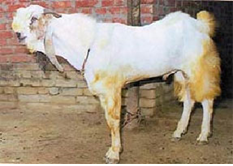

Beetal
- It is are found mainly in the state of Punjab
- These breeds are grown mainly for the purpose of milk and meat.
- Generally smaller than the breed of Jamunapari.
- Coat Colour is predominantly black;or brown with white spots of distering size
- Males usually possess beard.
- They are not so heavy in weight.
- Average birth weight – 3 kg.
- An adult female goat ranges between 40kgs to 50kgs, whereas an adult male ranges between 50kgs to 70kgs.
- Age at first kidding- 20-22 months.
- Average lactation yield – 150 kg.
- They are having the ability to give, one kg to two kgs of milk per day.
- Maximum yield being 591.5 kg in a lactation period of 177 days.
Barbari
- This is short haired and erect-horned goat popular in urban areas of Delhi, Uttar Pradesh, Gurgaon, Karnal, Panipat and Rohtak in Haryana state.
- Barbari breeds are grown mainly for milk and meat purpose.
- The color of this breed is white with light brown patches.
- An adult female goat weighs between 25kgs to 35kgs, whereas an adult male goat ranges between 35kgs to 45kgs.
- They are having the ability to give one kg to 1.5kgs of milk per day.
- This breed have better reproductive capabilities.
- They will give, 2 to 3 kids in parturition.
- They are usually stall-fed and are reported to yield 0.90-1.25 kg of milk(fat content 5%) a day in a lactation period of 108 days
- They are prolific breeder and kid twice in 12-15 months.
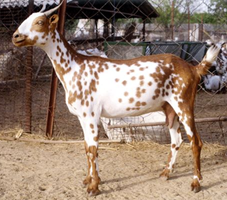
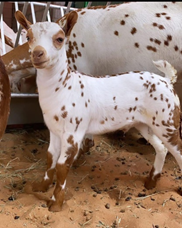
Tellicherry
- Tellicherry breed is also called as malabari breed.
- It is found mostly in the state of Kerala.
- It is grown mostly for the purpose of meat.
- Generally seen in white, purple and black colors.
- An adult female ranges in weight from 30 to 40kgs, whereas an adult male ranges between 40 to 50kgs.
- They can yield one kg to two kgs of milk per day.
- These types of breeds have better reproductive capabilities.
- They can give two to three kids in parturition.

Sirohi
- Coat colour is brown, white, and admixture of colours in typical patches; hair coarse and short.
- Compact and medium sized body.
- Tail twisted and carries coarse pointed hair.
- Horns are small and pointed, curved upward and backward.
- Average body weight of buckis 50 and doe is 23 kg.
- Average birth weight is 2.0 kg.
- Kiddingis once a year, twins are common.
- Average age at first kiddingis 19 months.
- Average lactation yield – 71 kg.
- Average lactation length – 175 days.
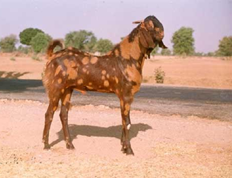
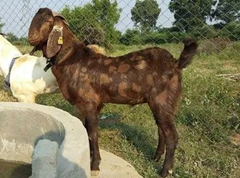
Osmanabadi
- Coat colour is predominantly black; white, brown and spotted occur.
- Long and short-haired type, based on presence or absence of long hair on the thighs and hind quarters.
- Tall and large size body and legs.
- Average birth weight 2.4 kg.
- Kiddingis once a year.
- Average age at first kidding19-20 months.
- It has good quality meat.
- Good yielders produce up to 3.5 kg a day.
- Average milk yield 170-180 kg per lactation.
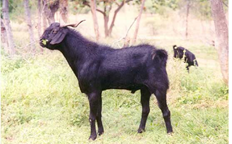
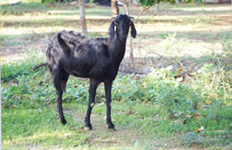
Kanni aadu
- These are the tallest goat breeds found in Thirunelveli and Ramanadhapuram districts of Tamilnadu.
- Black or white spots in the black background are the characteristics colors of this breed.
- They are usually grown for meat purpose.
- The adult females of this breed ranges from 25kgs to 30kgs and the adult males ranges from 35kgs to 40kgs in body weight.
- They are having ability to give birth to 2 to 3 kids.
- They grow well in the draught regions.
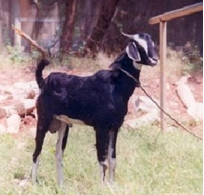
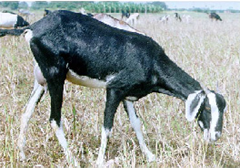
Kodi aadu
- These breeds are taller and found with different colors, but predominantly black
- They usually give birth to one or two kids.
- They are usually grown for the purpose of guiding the goat flocks, which goes for grazing..
- These types of breeds are mostly found in the districts of Sivagangai, Ramanadhapuram, and Tuticorin districts of Tamilnadu.
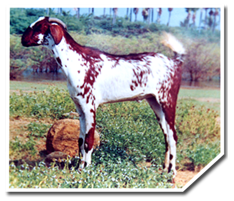
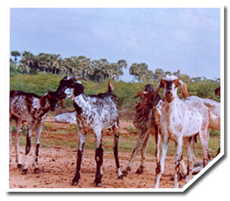
Black Bengal
- Coat colour is predominantly black, brown/grey and white with soft, glossy and short hairs.
- Dwarf in body size, legs short, straight back; both sexes are bearded.
- Average live weight of buck is 15 kg and doeis 12 kg.
- Most prolific among the Indian breeds.
- Multiple births are common – two, three or four kids are born at a time.
- Kidding is twice a year. Average litter size is 2.1.
- Average age at first kidding is 9-10 months.
- Average lactation yield is 53 kg. Lactation length is 90 to 120 days.
- Its skin is in great demand for high quality shoe-making.


Chegu
- Coat colour is predominantly white but greyish red and mixed colours are also seen.
- Average buck live weight of buck is 39 kg and doeis26 kg.
- Average birth weight is 2.0 kg.
- Kiddingis once a year and mostly single.
- Average lactation yield is 69 kg and lactation length is 187 days.
- Used for draught to carry salt and small loads.
- Have long hair with under coat of delicate fibre below (cashmere or pashm).
- Legs are medium sized. Face and muzzle is tapering. Ears are Small.
- Horns are bent upward, backward and outward with one or more twists.
- Used for draught (pack) to carry salt and small loads.
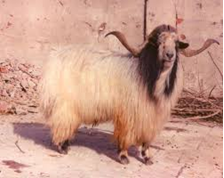
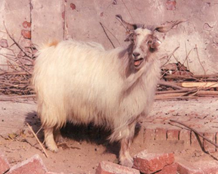
Changthangi
- Predominantly white and the rest are brown, grey and black. Undercoat white/grey; yields warm delicate fibre – pashmina (cashmere, pashm).
- Body and legs are small, have strong body and powerful legs.
- Ears are small, pricked and pointed outwards.
- Horns are large turning outward, upward and inward forming a semicircular ring.
- Average live weight of buck is 20 and doe is 20 kg; average birth weight is 2.1 kg.
- Kidding is once a year, normally single;
- Average age at first kidding is 20 months.
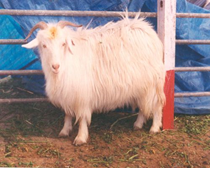
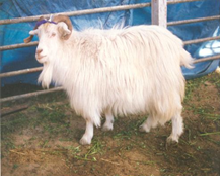
Mahbubnagari
- Goats in Mahbubnagar and nearby districts are known by the name Mabubnagari goats or by local name of “Palamuru Mekalu”.
- These goats are medium sized, leggy animals with varied coat colour i.e. white, black, brown, spotted, splashed, admixtures bicolour of black & brown, black and white, black & brown or tricolour etc.
- Flocks having more of complete black goats and white goats were also seen.
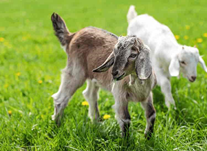
- Animals had straight or slightly convex head profile, straight or roman nose, medium sized pendulous ears, straight or backwardly curved pointed horns of varied lengths, wattles and beard are present in some animals of both sexes.
- The animals with facial stripes running from base of horns upto muzzle were also seen.
- Muzzle colour varied: pinkish, brownish and black. The horns and hooves were of grey.
Karauli
- It is a medium to large sized goat breed, reared for its meat and milk production.
- It is distributed in the Sawai Madhopur, Kota, Bundi, and Baran districts of Rajasthan.
- The average adult weight in males is about 52 kg, while the average daily milk yield is 1.5 kg.
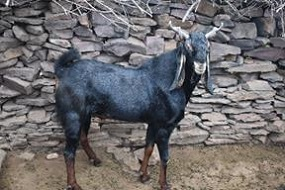
Gujari
- It is a largesized, dual-purpose goat breed found in Rajasthan.
- These goats have mixed coat colour of brown and white with white markings on face, leg, and abdomen.
- Adult male weigh around 69 kg while females weigh around 58 kg.
- The average daily milk yield is 1.62 kg.
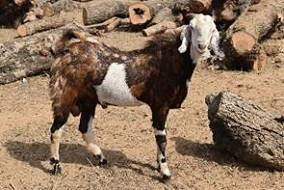
Anjori Goat
- It is a medium sized, meat purpose breed. It is distributed in Raipur, Durg, Rajnandgaon, Kanker, Dhamtari, Mahasamund districts of Chhattisgarh state.
- Majority of animals are brown in colour. It is hardy and well adapted to the local ecosystem.
- Average adult body weight for male is 35 kg and for female is 28 kg. Average milk production per lactation is 26 kg.
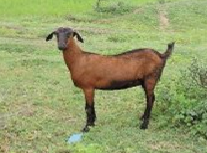
Andamani Goat
- It is a medium sized, meat purpose breed, mainly distributed in the Middle and North Andaman island.
- It is well adapted to the tropical humid climate of the island & are preferred for the excellent chevon quality.
- Average adult body weight for male is 29 kg and for female is 26 kg. Average milk production per lactation is 29 kg.
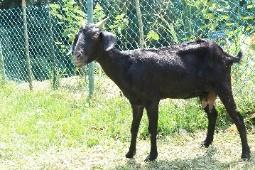
Sojat
- It is a large sized dual purpose goat; reared for both meat and milk purpose.
- Sojat is mainly distributed in Pali, Jodhpur, Nagaur and Jaisalmer districts of Rajasthan.
- Average adult weight is about 60.0 kg in males. Average milk yield in female is about 1 kg per day.
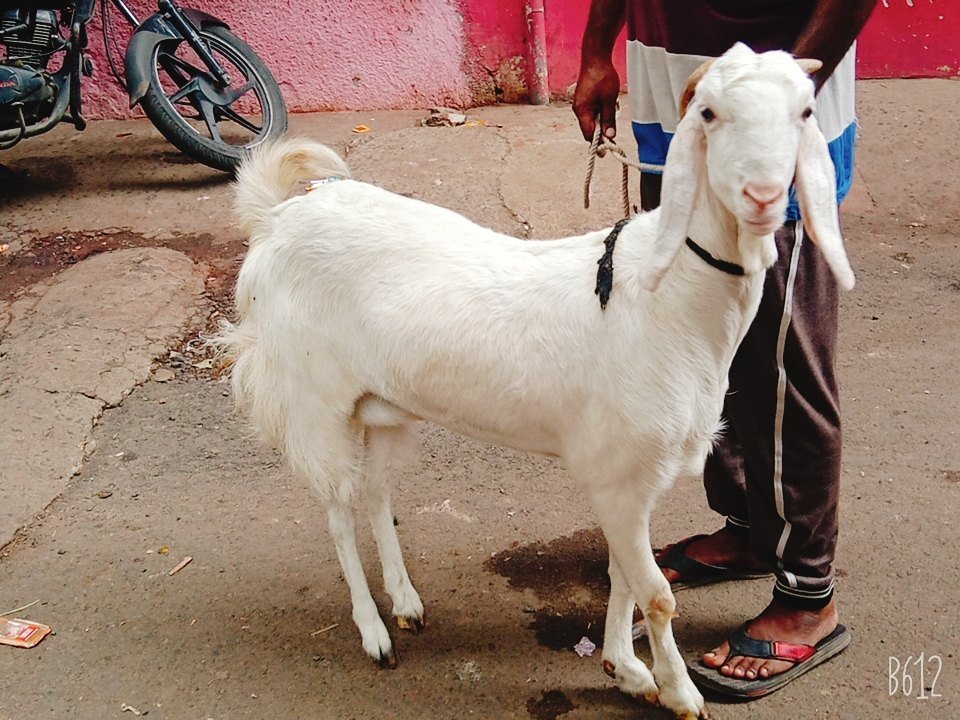
Teressa
- Teressa Goat: It is an indigenous goat breed maintained by Nicobari tribal farmers of Nicobar group of islands.
- These goats are generally tall, sturdy, brownish or dark tan or black or white in colour with white and black patches.
- Black hairs on dorsal midline up to the tail. Black colored muzzle, eyelids and hoofs. Peculiar white patch/line starting from inner canthus of both eyes or from eye brows and extending up to nostrils or mouth.
- Tail is medium to long. Large horns with flat base. Erected ears directing downwards. Adult body varies from 15 to 79kg.
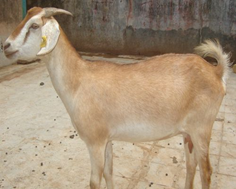
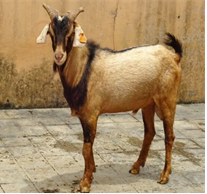
Kodi Adu Goat
- Kodi Adu goats are native to Thoothukudi & Ramanathapuram districts of Tamil Nadu.
- These are tall, long, lean and leggy animals with compact body.
- Based on body colour, they are classified into two colour varieties viz. Chem-Porai and Karum-Porai.
- Chem-Porai goats are white in colour with varying degree of reddish brown colour and intensity, whereas, Karum-Porai goats are white in colour with varying extent of splashes of black colour.
- They are reared mainly for meat. Adult body varies from 15 to 59kg.

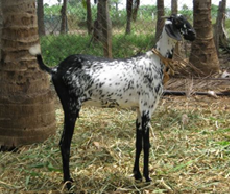
Assamhill
- Distributed in Assam and adjoining areas of the Meghalaya.
- Assam Hill goats are mostly white with occasional black patches on backline and legs. These goats are short legged with small body size.
- Both buck and does are bearded and have short cylindrical horns which are directed upwards and outwards. Ears are medium in size, horizontally placed with pointed tips.
- This is an important meat type animal with high prolificacy. These goats are reared mainly for meat.
- Adult body weight ranges from 15 to 26kg. Age at first kidding ranges from 337 to 447 days. Average litter size is 1.6.
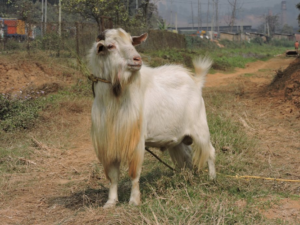
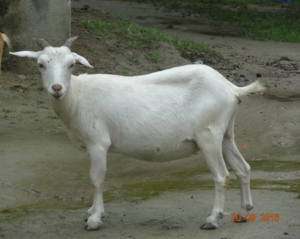
Gohilwadi
- The Gohilwadi breed is concentrated in the north-west arid and semi arid regions in the Bhavnagar, Amreli and Junagadh districts of Gujarat.
- Gohilwadi goats are multipurpose animals and are reared for milk, meat and fibre production. The traditional keepers of this breed are the Rabari and Bharwar communities (also known as Maldharis).
- These are relatively large animals with a black coat covered with coarse long hair. The nose line is slightly convex. Ears are tubular and drooping; both bucks and does have slightly twisted horns, turned backward.
- Age at first kidding is around 20 months, with a twinning percentage of 40 to 50%.
- Milk yield is about 1.7 kgs per day and the average lactation period is 227 days.
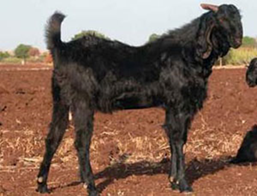
Kahmi
- This goat is native to Saurastra region of Gujarat.
- Coat color is unique – neck and face are reddish brown while rear abdominal part is black, locally called Kahmi.
- Ears are long, tubular & coiled, locally called veludi. Wattles are present in majority of goat. Forehead is convex.
- Horns are directed upwards and backwards. These goats are used both for meat & milk.
- Average daily milk yield is about 1.7kg. Adult body weight is 56kg in males and 48kg in females. Average liter size is 1.4.
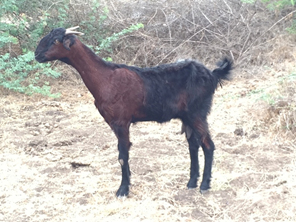
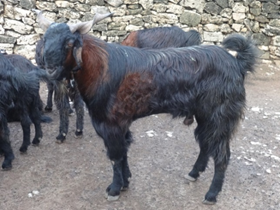
Kutchi
- The Kutchi or Kathiawari, is an important dual-purpose (meat and milk) goat breed, native to the Kutch district of Gujarat. They are medium-sized animals.
- Average milk yield is around 2 kg/day under stall fed conditions and 0.5 to 1 kg on grazing resources. The lactation length is about 6 to 7 months.
- Generally there is one kidding annually with a twinning percentage of 11, which increases with supplementary feeding under stall fed conditions.
- The coat is predominantly black, but a few white spotted animals are also found. Ears are medium in size, floppy and drooping with typical white markings.
- The coat is shaggy and dull in appearance with medium to long coarse hair.
- The annual yield of hair is about 200 gms when shorn twice a year. Both sexes have short, thick horns pointed upward.
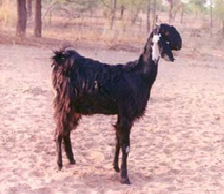
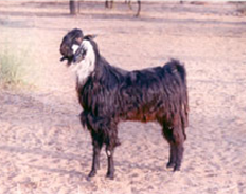
Mehsana
- The Mehsana is a dual purpose breed and is mainly found in the Mehsana, Banaskantha, Gandhinagar and Ahmedabad districts of Gujarat.
- The Mehsana is a large sized breed. The colour of the coat is black with white spots at the base of the ear.
- The Milk yield averages one kg/day. The litter size is mostly single. Average yield of hair per goat per year is 200 grams.
- Hair coat is long and coarse. Ears are always white. Both sexes have twisted horns curved upward and backward.
- The udder is moderately developed having large and conical teats.
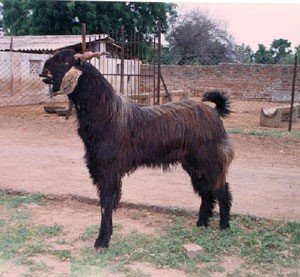
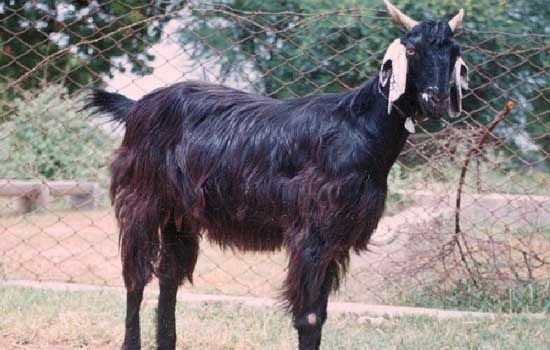
Surti
- The Surti breed is traditionally found in the Surat and Vadodara districts of South Gujarat.
- The Surti is a medium sized breed, white in colour with a highly developed udder. Ears are medium in size.
- Both sexes have small horns directed backwards. The breed is known to be a good dairy breed and yields on an average 2 kg of milk per day.
- The age at first kidding varies from 400-500 days.

Zalawadi
- Zalawadi goats are native to Gujarat. They are large animals. The coat is black and comprises long coarse hair.
- Ears are long, wide, leaf-like and drooping.
- Both sexes have long twisted horns, pointed upward. The kidding percentage is 78% and the litter size is mainly single (82%) and sometimes twins (18%).
- The average daily milk yield is 2 kg and the lactation period is about 200 days. The average annual yield of hair is 245

Gaddi
- The Gaddi breed, also known as the White Himalayan, is distributed throughout Chamba, Kangra, Kullu, Bilaspur, Simla, Kinnaur and Lahaul and Spiti in Himachal Pradesh and Dehradun, Nainital, Tehri Garhwal and the Chamoli districts of Uttarakhand.
- They are well built and sturdy animals and have drooping and pointed ears with long pointed horns bending upwards and backwards.
- Kidding takes place once a year with single births.
- The hair is about 17-19 cm long and lustrous; one shearing yields ½ to 1 kg of wool.
- The meat is coarse and devoid of fat, and milk yield averages about 1.5 kg/day.

Bakharwali
- These are white colored goats distributed in Jammu division of Jammu & Kashmir. Face or hind quarters are black in some animals. Pure black goats are also found.
- Whole body is covered with long hairs. These are large sized goats having convex head. Ears are cut and pendulous.
- Horns are screw type and are carried upwards and backwards. These are reared for meat and milk. Udder is pendulous.
- Adult body weight varies from 35 to 60kg in males and 30 to 50kg in females. Average daily milk yield is about 900g.

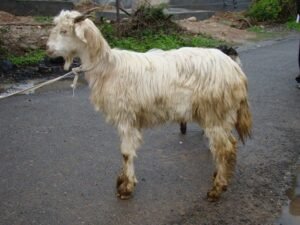
Bidri
- These are black colored goats found in north-eastern part of Karnataka.
- Muzzle, eyelids and hooves are black. Horns are present and are directed backward, outward and downward. Ears are pendulous.
- Goats are reared for meat only. Twining is common but first kidding is single.
- Average litter size is 1.7. Adult weight varies from 23 to 52kg in males and 19 to 45kg in females.
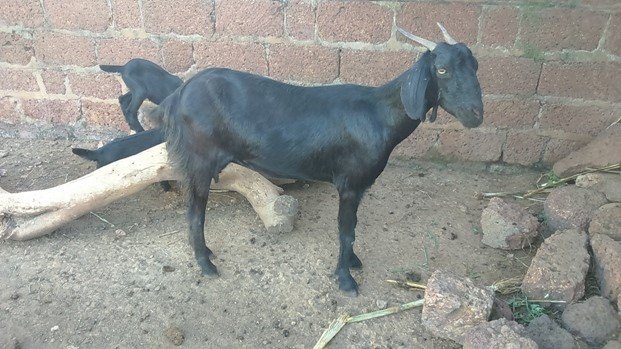
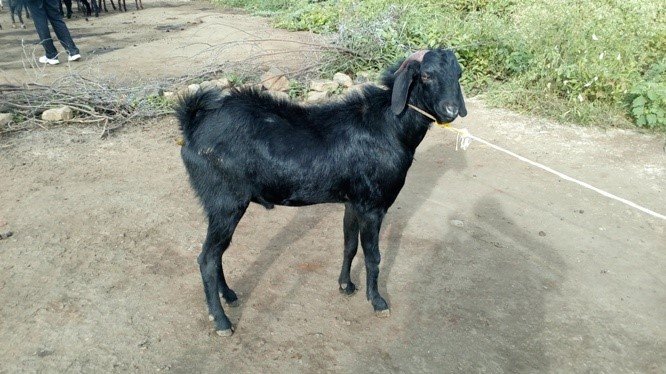
Nandidurga
- Nandidurga goats are distributed in Chitradurga, Tumkur and Davangere districts of Karnataka.
- Flocks are stationary. Goats are housed in kutcha sheds during night and are raised only on grazing.
- Coat colour is white and eyelids are brown or black. Ears are leafy and pendulous. Milking is not done as these goats are reared for meat.
- Twinning is common. Adult weight varies from 30 to 50 kg in males and 26 to 40 kg in females.
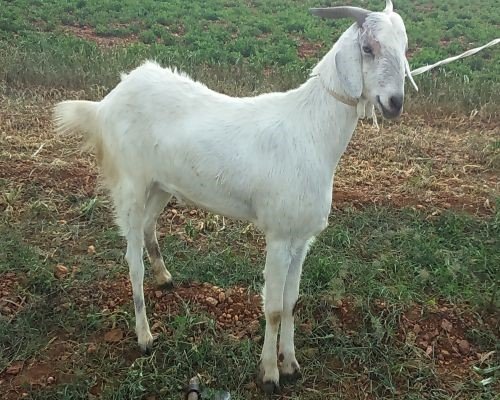
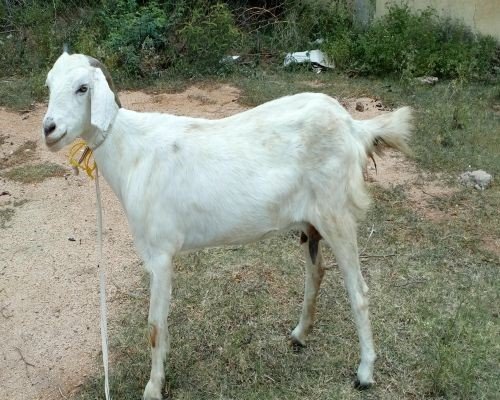
Attappady
- The Attappady Black breed is native to the Palakkad district of Kerala.
- This local goat breed is medium sized, lean and slender bodied and black in colour.
- They have bronze coloured eyes and black horns with curved backward oriented tips. The ears are black and pendulous and the tail is curved and bunchy.
- Attappady goats are poor milk producers and are reared mainly for meat. The birth weight of males and females is around 1.73 kg and 1.60 kg respectively.
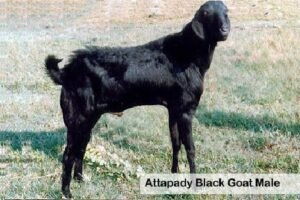
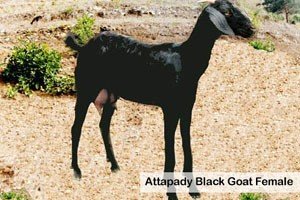
Berari
- Berari goats, also known as Lakhi and Gaorani.
- They are found in the Vidarbha region of Maharashtra and in the Nimarregion of Madhya Pradesh. Berari goats derive their name from the erstwhile ‘Berar’ region.
- The breed is primarily raised for meat by local farmers. The coat colour is light to dark tan. Thigh hair, eye brows and nostrils are tan to black in colour.
- The horns and ears are flat, leafy and drooping. The head is convex shaped with a slightly roman nose and with light or dark stripes on the lateral sides extending from the base of the horn to the nostril.
- Berari goats have a black hair line along the vertebral column extending up to the tail.
- These goats show good prolificacy, with the litter size ranging from single kids to four kids. Twinning is common. Milk yield for farm reared goats is about 43 kg in a lactation period of 123 days.
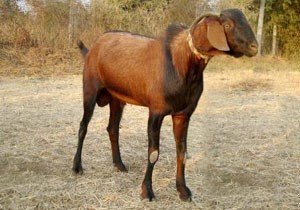
Konkan kanyal
- They are native to the Konkan region of Maharashtra, and are reared mostly by the Dhangar and Maratha communities for meat.
- These goats are mainly black with a white marking in a specific pattern–the ventral surface of the body is white and the legs have white ‘stockings’.
- Konkan Kanyal goats have bilateral white strips from nostrils to ears; a flat and broad forehead; flat, long drooping ears; backward, straight, pointed, cylindrical horns; white muzzle and long legs, laterally black, medially white from knee to the fetlock joint.
- The body weight of adult bucks and does averages 35 and 30 kg respectively.
- Konkan Kanyal goats are regular breeders and breed round the year, with a twinning percentage of about 66%.
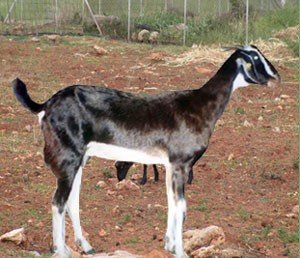
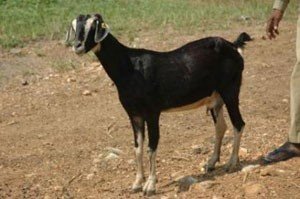
Sangamneri
- The semi arid region of Maharashtra comprising of Nasik, Ahmednagar and Pune districts forms the native habitat of the Sangamneri goat breed.
- They are medium-sized animals. The coat is completely white with mixtures of black and brown. Ears are long and drooping.
- Both sexes have horns directed backward and upward. The litter size is mainly single however 15 – 20% goats show twinning whereas triplets are rare.
- The average daily milk yield varies between 0.5 to 1.0 kg with an average lactation length of about 160 days.
- Although this breed is reared mainly for meat, some animals show a good milch potential. Dressing percentage is about 41% at 6 months, 45% at 9 months and 46% at 12 months of age.

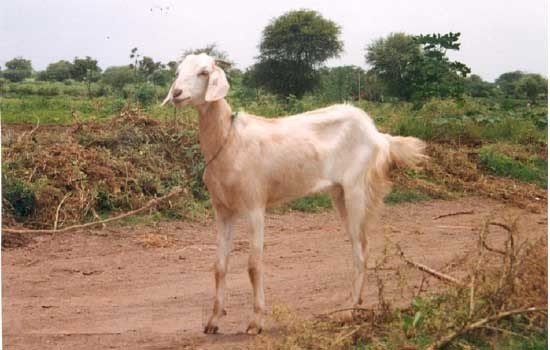
Sumine
- Synonyms include Apu-asu-ne
- Long haired breed with breeding tract in Nagaland
- Primarily used for fibre. Well adapted to the traditional open range zero input management system
- White with characteristic black markings on head, neck and legs. Horns are small sized, pointed and slightly curved backward
- Head is straight. Ears are horizontal. Beard is present. Presence of long hair in adult animals is the most important phenotypic character.
- The length of the fibre, however, is more in case of male as compared to that of females
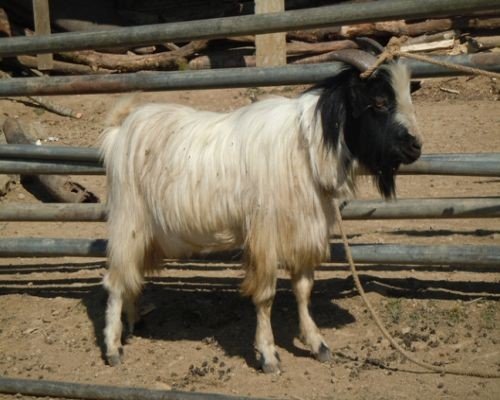
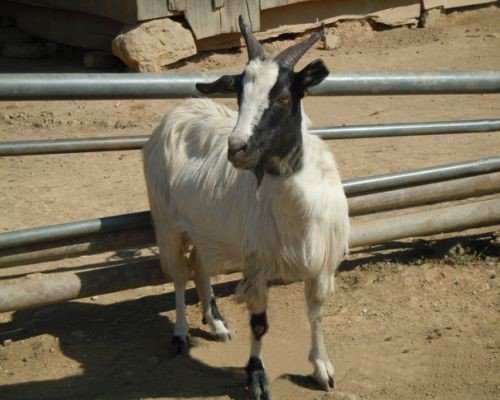
Ganjam
- The Ganjam breed, also known as Dalua, is found in eastern India, primarily in the Gajapati, Rayagada and Koraput districts of Odisha.
- A small number are also found in Sikkim. They are tall, leggy animals.
- The coat may be black, white, brown or spotted, but black predominates. The hair is short and lustrous. Ears are medium sized and both bucks and does have long, straight horns, directed upward with a medium-length tail.
- The kidding percentage is 82 and the litter size is primarily single (98.4%). Kidding takes place once a year.
- Milk yield is about 3 kgs a day and the average lactation period is 150 days.


Jakhrana
- The Jakhrana breed is found in the north-west arid and semi-arid regions mainly in eastern Rajasthan.
- They are large animals. The coat is predominantly black with white spots on the ears and the muzzle is short and lustrous. The face line is straight, with a narrow and slightly bulging forehead.
- The breed looks similar to the Beetal, the major difference being that the Jakhrana is taller. The ear length is medium and the udder is large, with conical teats.
- Does are reared for milk. A majority of the bucks are sold for meat, with a small number retained for breeding.
- Jakhrana goats graze on natural pastures but can also be managed on stall feeding. This breed is well known for its milk potential averaging a daily yield between 2 to 5 litres.
- The milk has a relatively higher fat content (5.06%), SNF (8.60%) and protein (3.70%).
- These goats show good prolificacy and the kidding percentage is 90. Kidding takes place twice a year (June – July and October – November), with a twinning percentage of 80 – 90%.
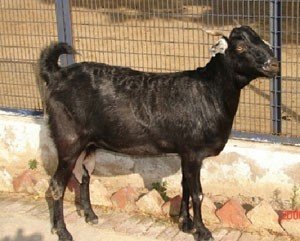
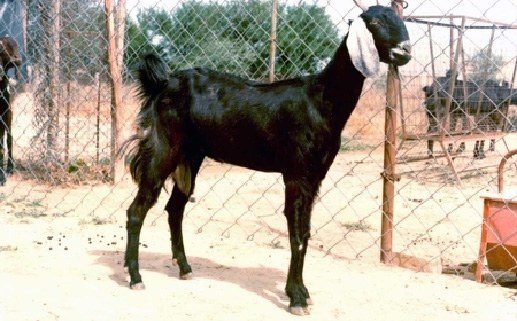
Marwari
- The native tract of the Marwari goat breed is western Rajasthan – the districts of Barmer, Jaisalmer, Bikaner, Jodhpur, Jalore, Pali and Nagaur.
- This is a dual purpose breed, reared for both mutton and milk, and is well adapted to the harsh environment of the Thar desert.
- The Marwari goat is a medium sized animal, predominantly black in colour. The hair covering is lustrous and The tail is small and thin.
- The udders are fairly well developed but small and round with small teats placed laterally. The milk yield varies from 0.5 to 1 kg when reared on grazing and from 2 to 3 kg under stall fed conditions.
- Kidding is primarily single births, with a twinning percentage of around 10%, which increases when the goats are kept under stall fed conditions and given supplementary feed
- The thick hair protects the animal from the extremes of temperature found in this region. The hair is used to weave traditional harnesses for camels, and also carpets and bags, the latter used by potters.
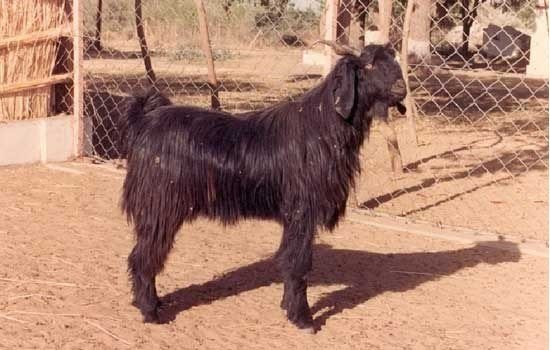
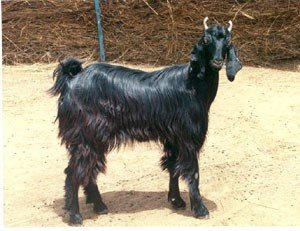
Salem Black
- Synonyms are Karuppadu (in vernacular tamil language)
- Breeding tract is Salem, dharmapuri, erode / periyar, krishnagiri (tamilnadu)
- Meat of this breed is considered to be very tasty compared to other goats
- Completely black with glossy hair coat. Horns present. No typical horn pattern however mostly directed upward and backward and sharp at the tip.
- Salem black goats are tall, long, lean and leggy animals with compact body. Head is medium in length.
- The eyes are small and bright and the eyelashes are black in colour. The ears are medium in length, leaf-like and semi-pendulous.
- Neck is thick, broad and well set to the thorax in males. Hairy and fiber type is Coarse/carpet
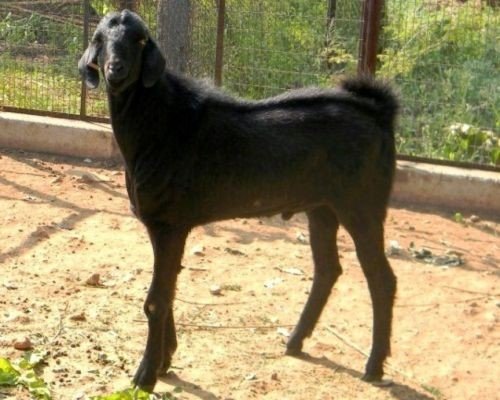

Rohikhandi
- Native to Rohilkhand region of Uttar Pradesh, and is reared for meat and milk.
- Coat colour is predominantly black with star or patch on neck and face in some animals.
- Majority of animals are horned which are curved, and directed laterally and outwardly.
- Beard and wattles are absent in both sexes. Forehead is slightly convex.
- Tuft of hair (black or brown) is present in thigh region. Tail is bunchy.
- Adult body weight ranges from 25 to 36kg in male and from 21 to 31kg in female.
- Twinning is common and triplets are frequently observed. Average litter size is 1.57. Daily milk yield ranges from 450 to 740g.
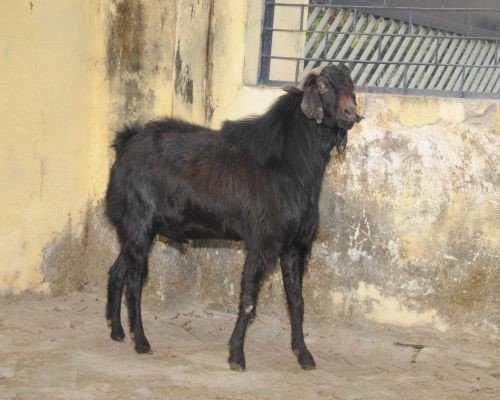
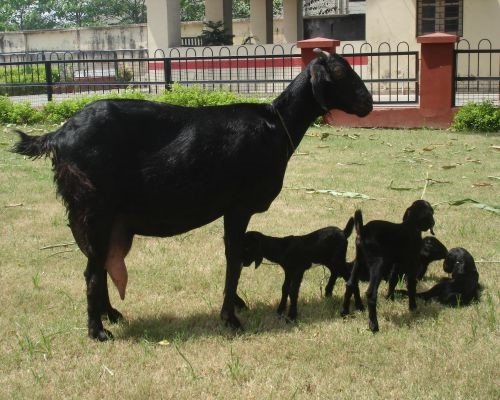
Pantja
- Synonym is Pantuja. Breeding tract include Udhamsingh nagar, nanital (uttarakhand)
- It is a Dual purpose breed (chevon, milk). Farmers relish pantja chevon and hence, buckling are castrated at 7-10 days
- Fawn to brown colour, which becomes lighter ventrally
- Horns are small sized(<15cm). Triangular, twisted, slightly upwards and backwards, pointed tip
- White streak on either side of face. Head is slightly convex. Ears are pendulous
